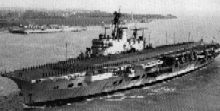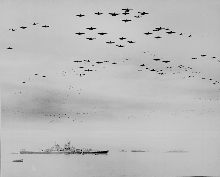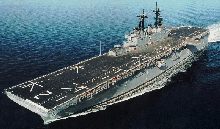| BACK |
 |
| The famous
HMS Ark Royal II aircraft carrier will look very familiar to most
of you. |
 |
| Breathtaking
and awe inspiring! |
 |
| USS Essex
in blazing color. |
Lesson
Fourteen: Carrier Landings
By 3NG's Wyatt and Wade |
| First, let me inform you that our goal is not to
instruct you where exactly to set your speed, flaps, altitude,
etc. Each pilot flies his aircraft differently. Some
like to take a long, slow approach and some like the quick and
fast method. If you're not having much success with the
quick/fast method, we do suggest you try the long/slow method.
All we can do is share our experience and some guidelines to
follow. Every night, you should practice carrier-based and
land-based takeoffs and landings. Also, when practicing, we
suggest you make your difficulty settings at least 85 percent. Landing on a carrier can be a tricky proposition. It requires patience, practice, and concentration. The first thing to do is distance your aircraft from the carrier. That way, you can make your turn, get lined up well in advance, and make sure your aircraft is in order. Turn back toward the carrier when you can no longer see the landing indicator lights at the aft of the Ark Royal. On final approach, announce "f" via keyboard. Drop your gear when cleared to land and steadily slow your aircraft prior to crossing the wake of the carrier. Wyatt's personal preferences at this point when landing on the HMS York:
Again, your preferences may differ. Just remember that high and fast is preferable to low and slow. Check your speed and altitude when you cross the wake on your first few successful attempts. If you make an easy landing, then try to hit that speed and altitude every time you make your final approach. Ready for touchdown. You must know the stall speed of your aircraft when landing and make your speed a few mphs above it. In a Hawker, you can get away with a little less than 100 mph, whereas Corsairs will stall at less than 110 mph. If you tend to splash short, try a little more speed. If you're skidding right across the deck and into the drink, try less speed. If you drop like a pancake, try a little more speed and less flaps. DO NOT hit your tail hook (forward slash key /) until you hear your tires squeak. And by all means make sure your nose is up when you land to avoid prop strike. Now that you're safely on deck, park your plane on the starboard side (where tower is) and enjoy watching other pilots' attempts to land. It's best to keep speed down to 10 mph while on deck. CARRIER LANDINGS WITH MORE THAN 2 PILOTS: When we have numerous pilots to land, 1 pilot shall be appointed the lead man. Then, all other pilots line up after him. Everyone should make a turn at the same location the lead man turns to make his approach. Make your separation at least 2000 ft. If you get too close on approach, break off and get to the back of the line. If you abort landing, continue flying past carrier deck and circle to back of line. We can land 8 guys safely within 30 minutes. Practice a couple of landings before getting online. It will do you wonders. BACK |